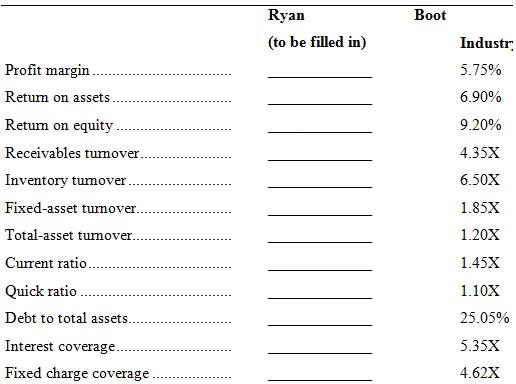a. Analyze Ryan Boot Company, using ratio analysis. Compute the ratios on the prior page for Ryan
Question:
a. Analyze Ryan Boot Company, using ratio analysis. Compute the ratios on the prior page for Ryan and compare them to the industry data that is given. Discuss the weak points, strong points, and what you think should be done to improve the company’s performance.
b. In your analysis, calculate the overall break-even point in sales dollars and the cash break-even point. Also compute the degree of operating leverage, degree of financial leverage, and degree of combined leverage. (Use footnote 2 for DOL and footnote 3 in the chapter for DCL.)
c. Use the information in parts a and b to discuss the risk associated with this company. Given the risk, decide whether a bank should loan funds to Ryan Boot.
Ryan Boot Company is trying to plan the funds needed for 2014. The management anticipates an increase in sales of 20 percent, which can be absorbed without increasing fixed assets.
d. What would be Ryan’s needs for external funds based on the current balance sheet? Compute RNF (required new funds). Notes payable (current) and bonds are not part of the liability calculation.
e. What would be the required new funds if the company brings its ratios into line with the industry average during 2014? Specifically examine receivables turnover, inventory turnover, and the profit margin. Use the new values to recompute the factors in RNF (assume liabilities stay the same).
f. Do not calculate, only comment on these questions. How would required new funds change if the company:
(1) Were at full capacity?
(2) Raised the dividend payout ratio?
(3) Suffered a decreased growth in sales?
(4) Faced an accelerated inflation rate?

Income Statement—2013 | |
Sates (credit)........................................................................... | $7,000,000 |
Fixed costs*............................................................................ | 2,100,000 |
Variable costs (0.60)............................................................... | 4,200,000 |
Earnings before interest and taxes.......................................... | 700,000 |
Less: Interest........................................................................ | 250,000 |
Earnings before taxes.............................................................. | 450,000 |
Less: Taxes @ 35%.............................................................. | 157,500 |
Earnings after taxes................................................................. | $ 292,500 |
Dividends (40% payout)...................................................... | 117,000 |
Increased retained earnings..................................................... | $ 175,500 |
*Fixed costs include (a) lease expense of $200,000 and (b) depreciation of $500,000.
| |
A dividend is a distribution of a portion of company’s earnings, decided and managed by the company’s board of directors, and paid to the shareholders. Dividends are given on the shares. It is a token reward paid to the shareholders for their...
Step by Step Answer:

Foundations of Financial Management
ISBN: 978-1259194078
15th edition
Authors: Stanley Block, Geoffrey Hirt, Bartley Danielsen






